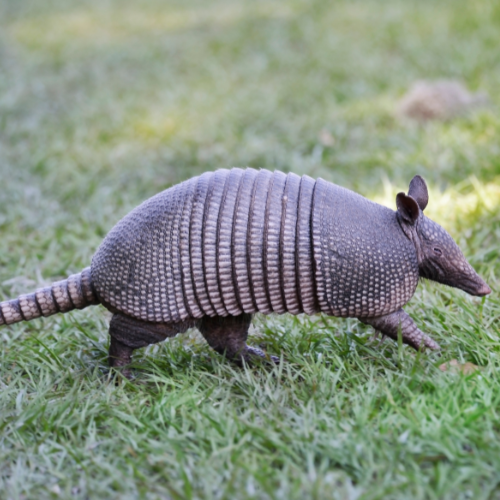Armadillos, specifically the Nine-banded variety, are the type predominantly found in our region. These unique creatures native to the Americas, are increasingly making their presence felt in neighborhoods, particularly in regions such as Central and Southwest Florida. They are known for their distinctive armored shells and have become a topic of interest and concern among residents. The growing presence of armadillos in residential areas can lead to various challenges for homeowners and property managers, as they adapt to living alongside these intriguing yet often underestimated wildlife.
These creatures, with their distinctive armored shell, are not native to Florida. They migrated from Central America and have since adapted well to the varied landscapes of Central and Southwest Florida. While they may appear harmless and even fascinating due to their unique appearance, they can become a significant nuisance when they make your property their home.
One of the primary problems with these animals is their digging habits. Their search for food, which mainly consists of insects and grubs, leads them to dig holes in gardens, lawns, and near the foundations of homes. This behavior not only ruins the aesthetic appeal of your yard but can also cause structural damage to buildings and create unsafe walking surfaces. In their quest for shelter, they can burrow under porches, decks, and other structures, compromising their stability. Beyond property damage, armadillos are carriers of the bacterium that causes leprosy. Although the risk of transmission to humans is low, it's a health concern that cannot be ignored, especially when these animals are frequenting areas where pets and children play.
Given these challenges, it might be tempting to tackle the problem yourself. However, DIY methods often fall short for several reasons. Firstly, capturing armadillos is not as simple as it may seem. These animals are surprisingly agile and can be difficult to trap. Additionally, Florida wildlife regulations require specific handling methods to ensure the humane treatment of these creatures. Without proper knowledge and tools, DIY attempts can lead to injury and possible legal ramifications.
Moreover, dealing with an armadillo infestation is not just about removing the visible pests. It's about understanding and addressing the underlying reasons they are attracted to your property in the first place. Professional wildlife control services, like ours at ARR Nuisance Wildlife Control, employ a holistic approach. We assess the situation, identify the attractants, humanely remove the nuisance animals, and implement strategies to prevent future invasions.
Interestingly, despite their tough exterior, armadillos are quite sensitive creatures. They have poor eyesight and rely heavily on their sense of smell to navigate and find food. Another fascinating fact is that the Nine-banded armadillo almost always gives birth to identical quadruplets, a rare trait in the animal kingdom.
Wildlife encounters have been on the rise in urban and suburban areas of Florida. This increase is partly due to habitat loss and the adaptability of these animals to human-modified environments. We have noted a significant rise in calls related to armadillo problems in recent years, indicating a growing need for effective wildlife management solutions in our communities.
We pride ourselves on our expertise in dealing with all kinds of wildlife nuisances, including armadillos. Our team of professionals is equipped with the knowledge, experience, and tools necessary to manage these situations effectively and humanely. We not only focus on immediate resolution but also provide guidance and services to prevent future wildlife issues.
Remember, if you're facing wildlife control issues, don't hesitate to contact us. We are here to provide you with expert advice and effective solutions tailored to your specific situation. Let us help you reclaim your peace of mind and the safety of your property.
Frequently Asked Armadillo Questions
Q1. Can They Swim?
A1. Surprisingly, armadillos are quite adept swimmers. Despite their heavy looking shell, they have a unique ability to swim across water bodies. They achieve this by inflating their stomachs and intestines with air, which increases their buoyancy. This allows them to float and swim efficiently. In situations where they need to cross underwater, they can hold their breath for up to six minutes, walking along the bottom of streams and small bodies of water.
Q2. Do Armadillos Have Teeth?
A2. Answer: Yes, they do have teeth, but their dental structure is quite different from other mammals. Their teeth are peglike, small, and without enamel. They have more teeth than most mammals; a Nine-banded armadillo can have up to 32 teeth. However, their teeth are suited for grinding up the insects and grubs they eat, not for biting or tearing, which is why they pose minimal threat in terms of biting.
Q3. Why Do They Roll into a Ball?
A3. The popular belief that all armadillos can roll into a ball is actually a misconception. Only one species, the Three-banded, can roll up completely into a ball as a defensive mechanism. This unique ability helps protect them from predators, as their hard shell can fend off attacks when they are completely enclosed. The Nine-banded found in Florida do not roll into a ball; instead, they rely on their armored shell and digging abilities to escape danger.
All Rights Reserved | ARR Nuisance Wildlife Control

